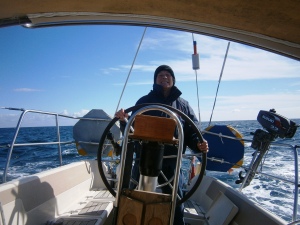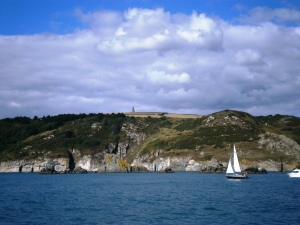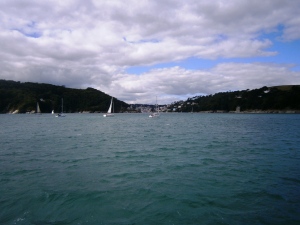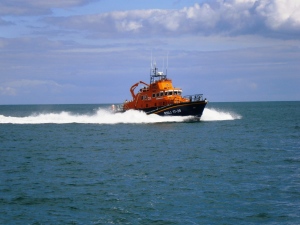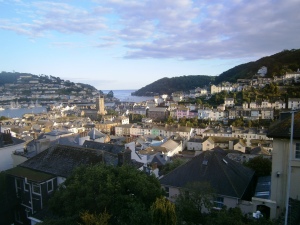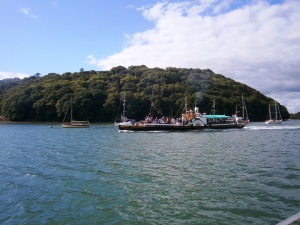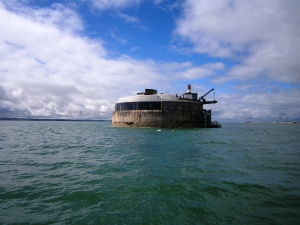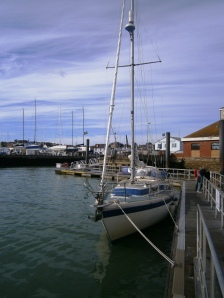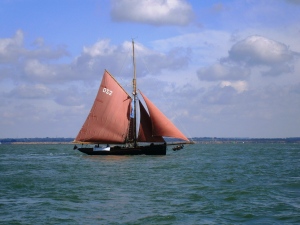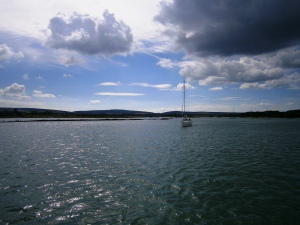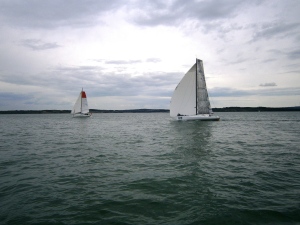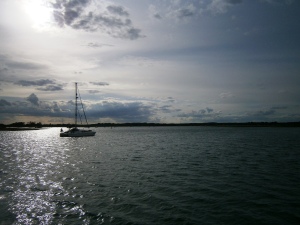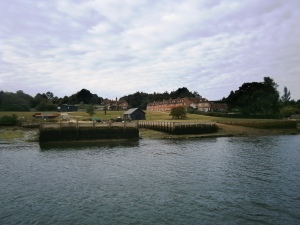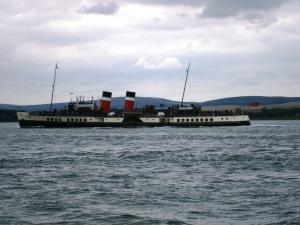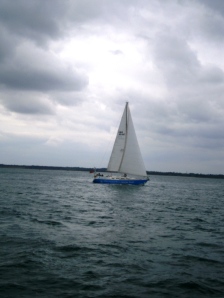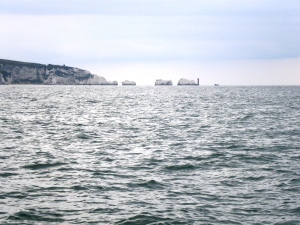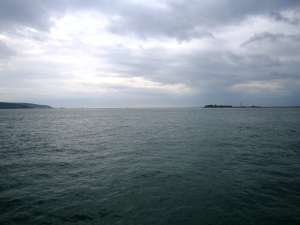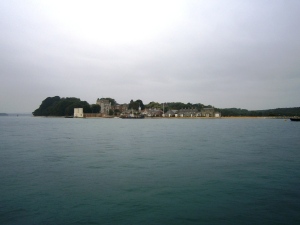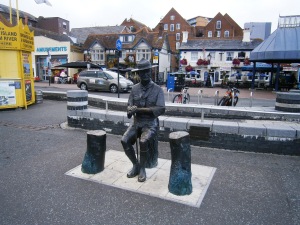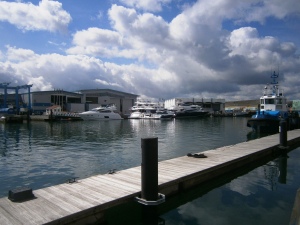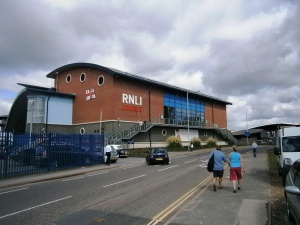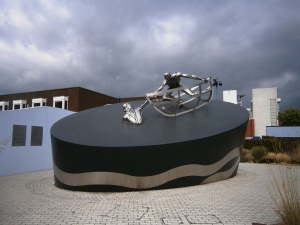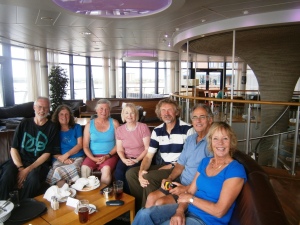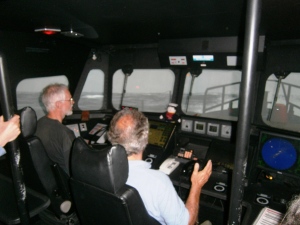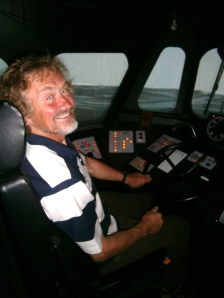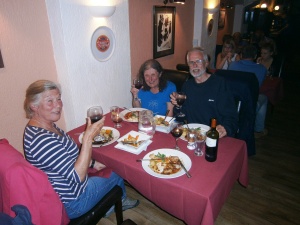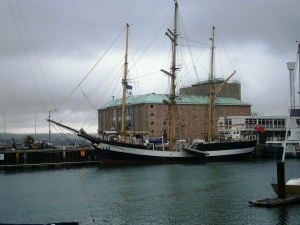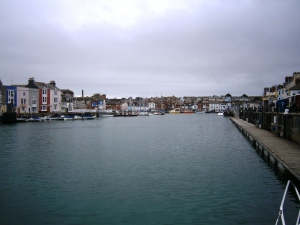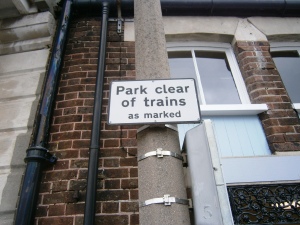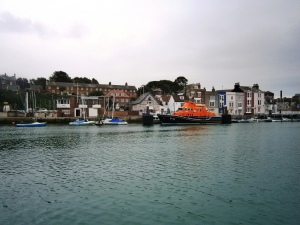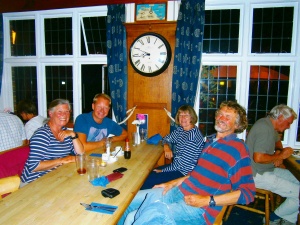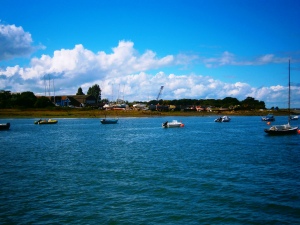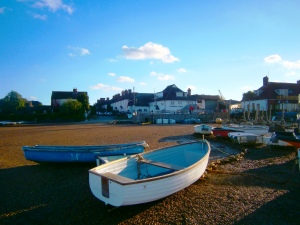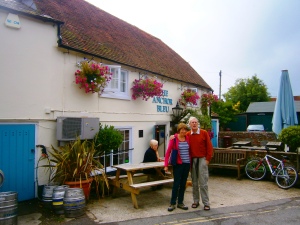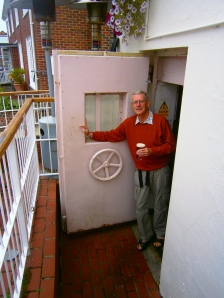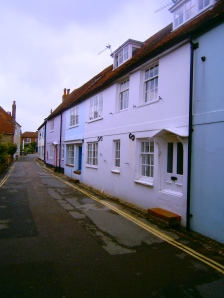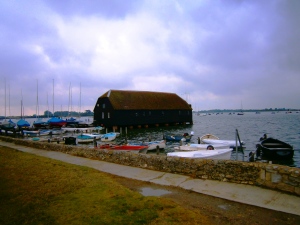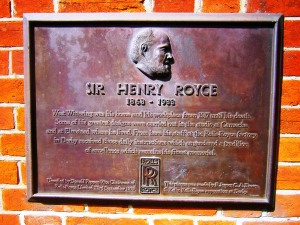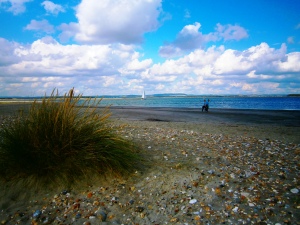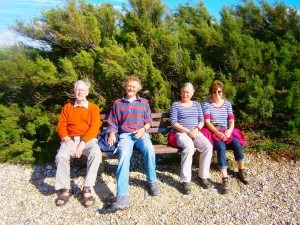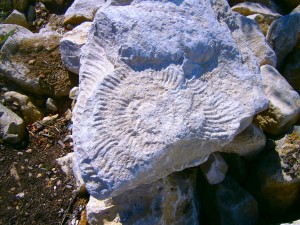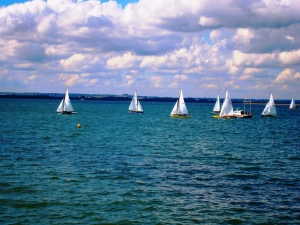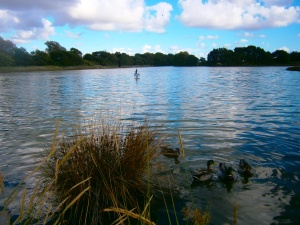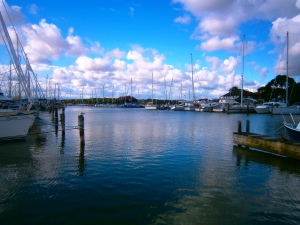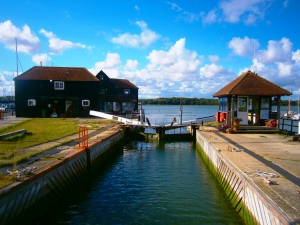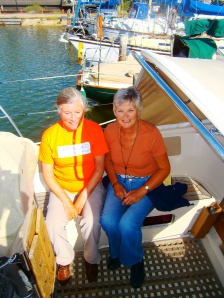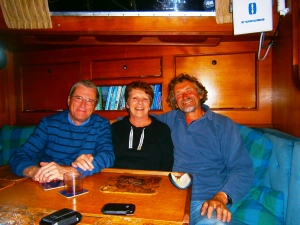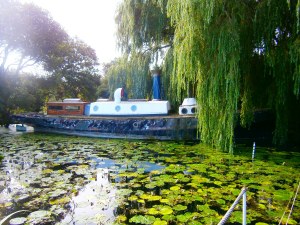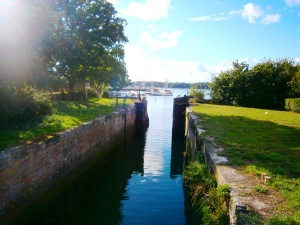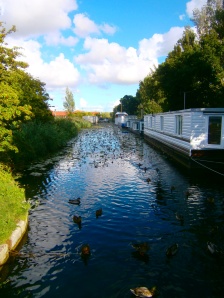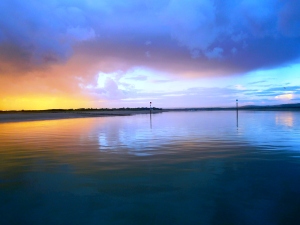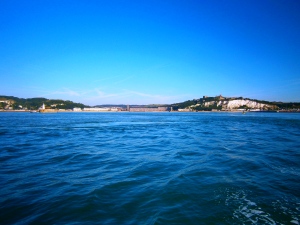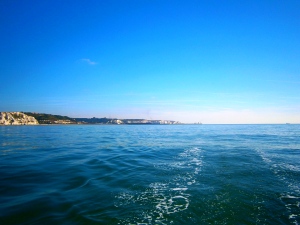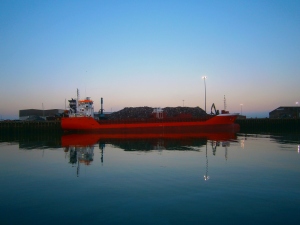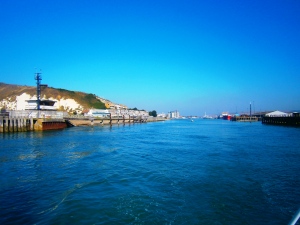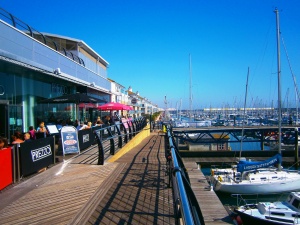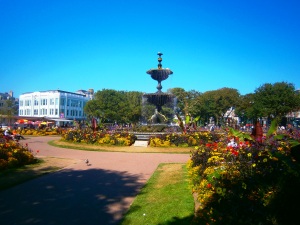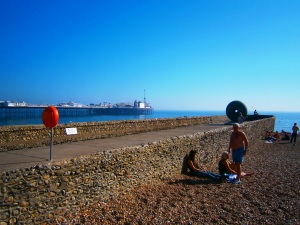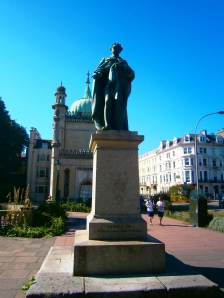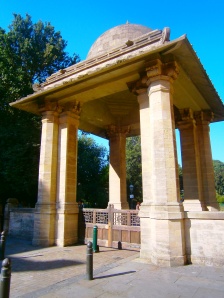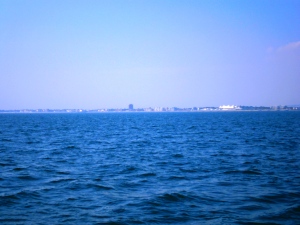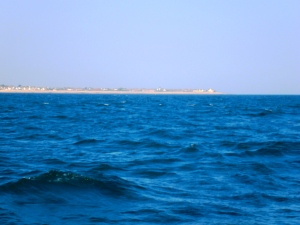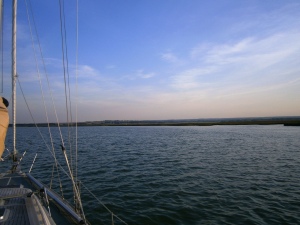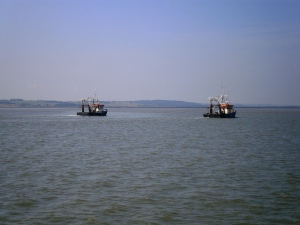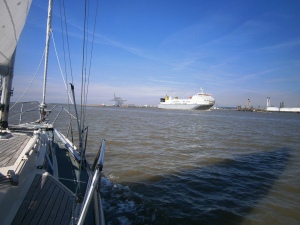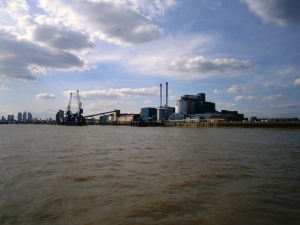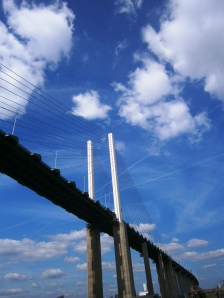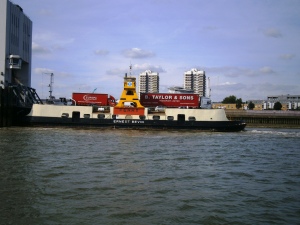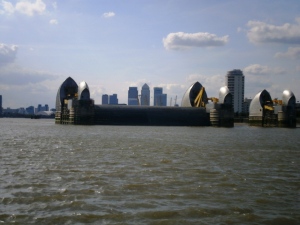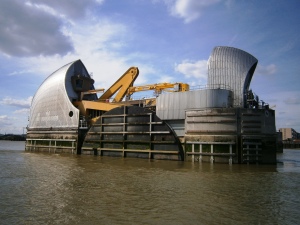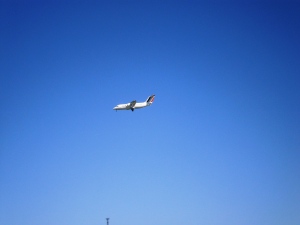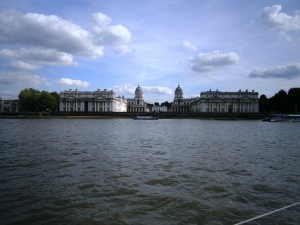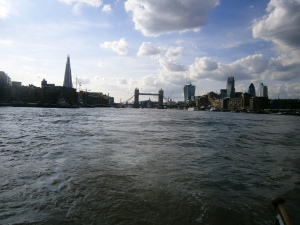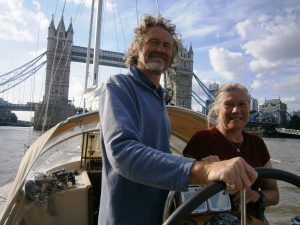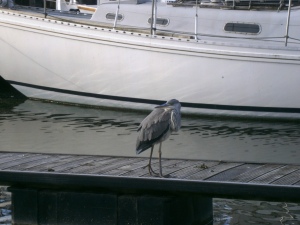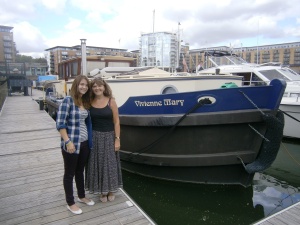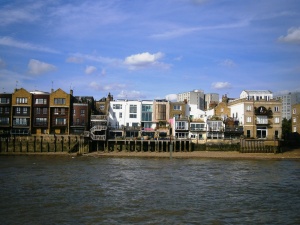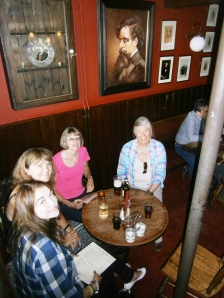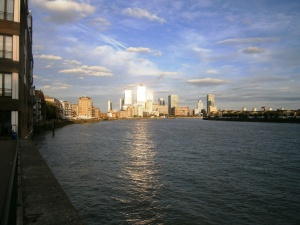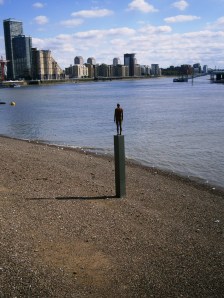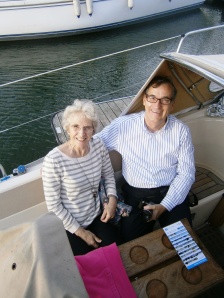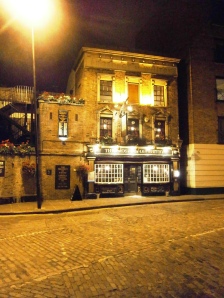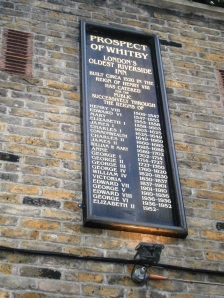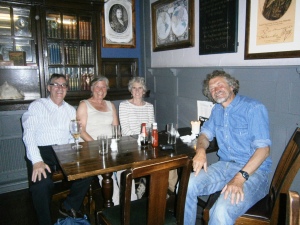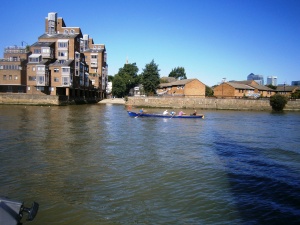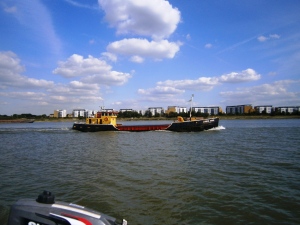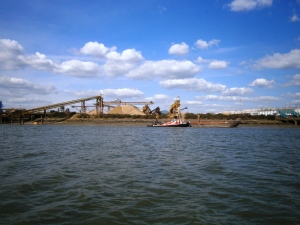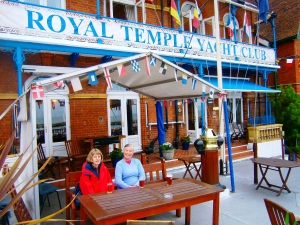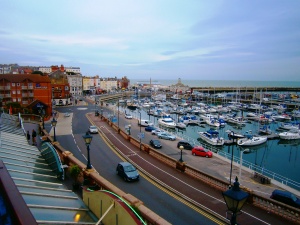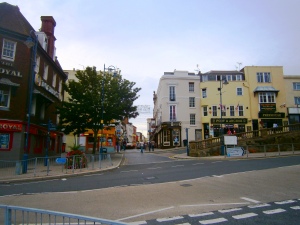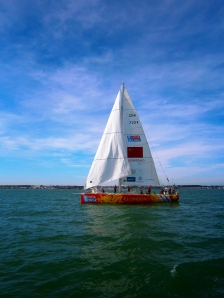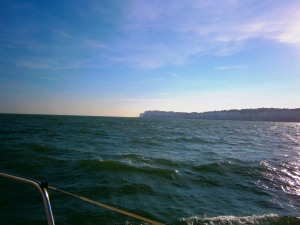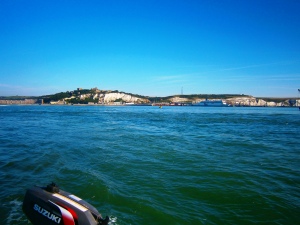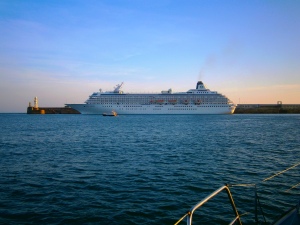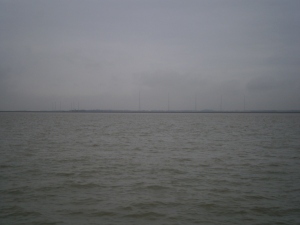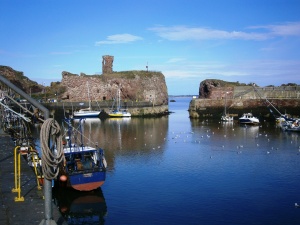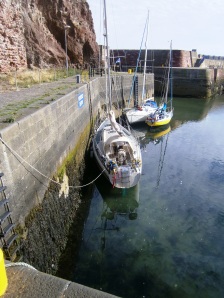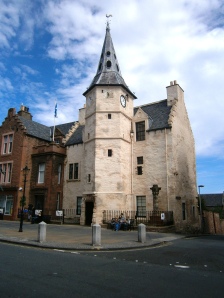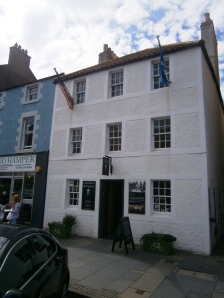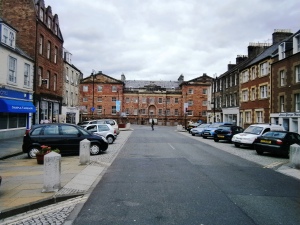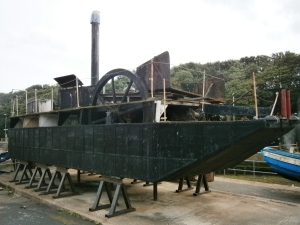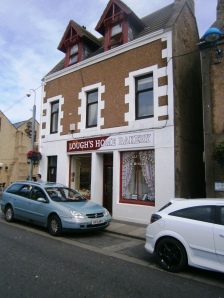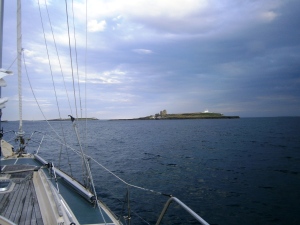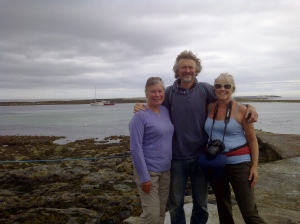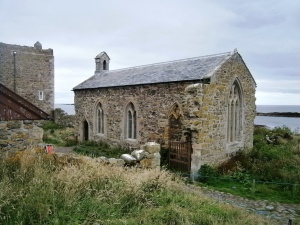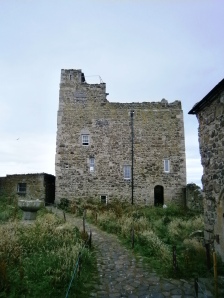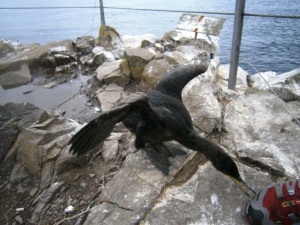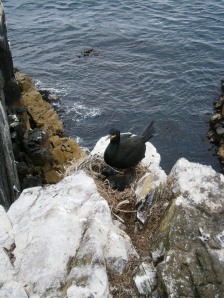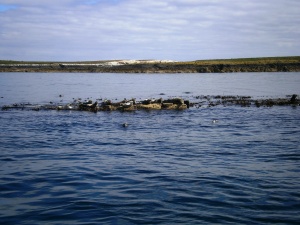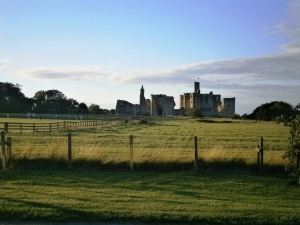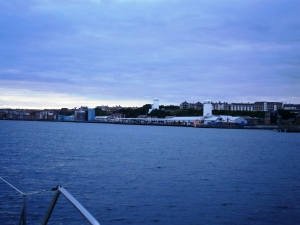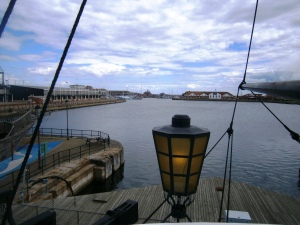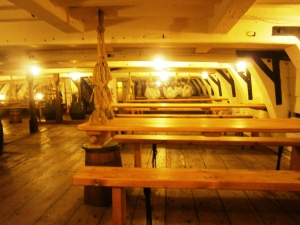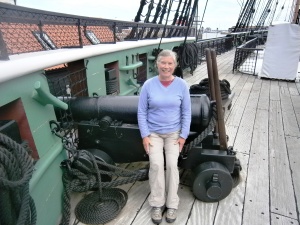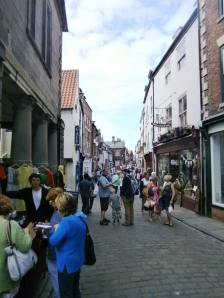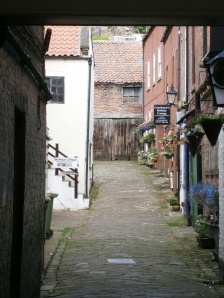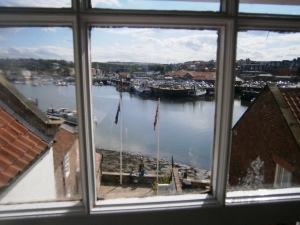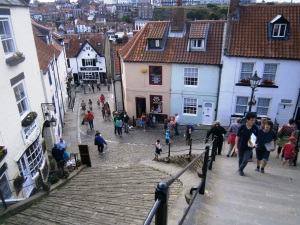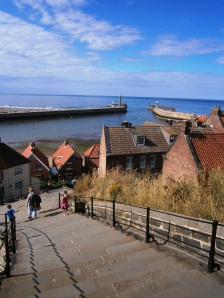Tuesday 30th July – Whitehills to Peterhead
The tides round Rattray Head will not be in our favour until the afternoon so we decide to leave at midday. Judith and Yvonne do a bit of shopping essentials whilst John and Charles do engine checks and treat the companionway steps with teak sealer. Most of the internal teak has now been cleaned and treated.
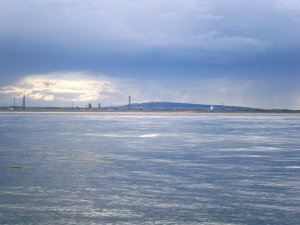
North Sea Gas and oil usually comes ashore in pipelines to innocuous looking terminals, such as the St. Fergus terminal north of Aberdeen
We leave at 1145 in glorious weather with a fair wind. We set one reef but after a while the wind drops so the reef comes out but the wind keeps dropping and we end up motor sailing. The coast here is lovely and we can see the land clearly as we sail along about half a mile off-shore. We pass some pretty little villages, such as Findochty (pronounced ‘Finnechty’) with its brightly painted houses nestled at the foot of the cliffs and Cullen, reknown for the fish soup Cullen Skink which is based on smoked haddock.

The eerie ruins of Slains Castle at Cruden Bay, south of Peterhead, were the inspiration for Bram Stoker’s story of Dracula in 1895
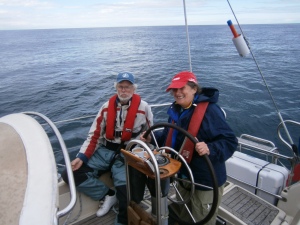
Charles and Judith Saunders accompanied us on the trip between Whitehills (on the Moray Firth) and Burntisland (in the Firth of Forth)
By the time we reach Rattray Head (a major headland on this coast at the end of the Moray Firth) we are doing 7.6 knots with the full tide helping us along. Rattray Head is a disappointing headland – just sand dunes and low-lying country, not the impressive headlands and cliffs of other heads but nevertheless the tide and overfalls around it are real enough. South of Rattray we pass the St. Fergus gas terminal, a collection of buildings, tanks and flare stacks. This is the first of the gas and oil terminals we have seen on the east coast – innocuous places where so much of the North Sea bonanza lands for our use.
We pass Fraserburgh, which is a big commercial and fishing port that does not really welcome small yachts and press on. We approach Peterhead and get permission from the harbour control to enter after a large oil platform service vessel. Peterhead is a major fishing and oil industry support port so there is a strict control on ship movements through the harbour entrance. We see that some of the parapet of the massive harbour wall is missing – perhaps a result of the devastating storms last winter on this coast that caused £22 million of damage at Peterhead alone.

Sometime harbour masters and marina managers go that little bit extra mile to help their customers. One such is Bruce at Peterhead. Even the rather unprepossessing area round his office is bright and tidy
We contact the marina by VHF to get our berthing instructions and the assistant marina manager, Bruce, meets us on the pontoons to take our lines. He is a very helpful and friendly person and the marina is tidy with the little garden looking a picture. Bruce is one of a kind along with his friend Bertie, the harbour master at Whitehills – friendly, helpful and efficient. Such people make a real difference and a lasting impression on our trip.

Supporting the North Sea oil development and production has long been a lifeline to many North Sea ports that would otherwise have struggled as fish stocks declined. Inevitably the equipment is big and specialised such as this support ship at Peterhead. There is currently a boom in exploration as the bigger companies pull out and the smaller oil companies who have taken over try to develop the more marginal oil fields. Some within the oil industry believe there is still two generations of development to go.
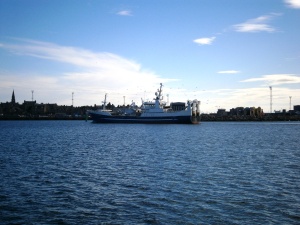
Peterhead was Britain’s largest whaling port until the end of the 19th Century. Whilst fishing has declined somewhat in recent years it is still one of the largest white fish ports in Europe, with much of its catch exported. This large, well kept fishing boat is one of the pelagic fleet (i.e they catch fish that swim near the surface such as herring and mackerel). Hearsay at Peterhead suggested that although these ships use up the annual quota of fish in three months they are highly profitable, as the good state of this ship would seem to indicate.
Ship’s log
Day’s run: 33.5 nm
Total miles to date: 1571.1 nm
Engine hours: 4.0 hours
Total engine hours: 187.2 hours
Hours sailed: 5.0 Hours
Total hours sailed; 343.7 hours
Wednesday 31st July – Peterhead to Stonehaven
We leave at 0800 to take the best of the tide south. We have to wait for clearance to leave from port control whilst one of the very big pelagic fishing boats manoeuvres. Once out at sea we set full sails and sail south in a fresh breeze in sunny weather. After a while the breeze fails so we motor sail. (So often good weather is a result of high pressure which means light breezes). We motor south and as we approach Aberdeen the wind picks up so we reset the sails and tack down the coast into Aberdeen bay.
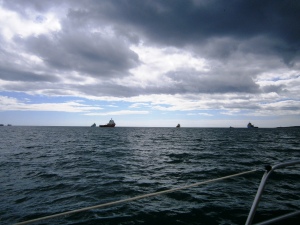
Some of the large number of oil platform support vessels anchored outside Aberdeen, “awaiting orders”
There are large numbers of oil platform service ships anchored off “awaiting orders”. At least one is painted bright yellow – we assume this is an emergency vessel.
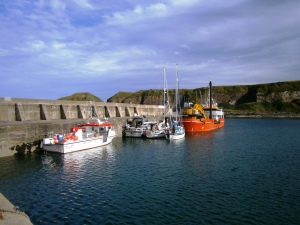
Visitors moorings at Stonehaven – squashed between the dredger and the fishing fleet. Fishermen always jealously guard their piece of harbour wall!

Wednesday evening racing at Stonehaven – ex Staunton Harold SC member John Deacon now sails a Blaze here – we hear the red mist is alive and well!
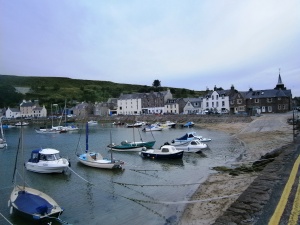
The Georgian harbour front at Stonehaven. Many of the buildings are built with the attractive local red sandstone. This whole area of coast was devastated by two great storms last winter with some ground floor flats still not being back in occupation in Stonehaven. Boats were flung up the harbour wall (despite the harbour gates being shut) and large rocks off the shore were hurled into buildings. The local volunteer life guard has been permanently put out of action due to the total wrecking of their equipment by the storms.
Eventually we reach Stonehaven. The harbour master is absent so the local fishermen direct us to the berth on the harbour wall allocated for visiting yachts. The only problem is a big, rusty Danish dredger that is taking up most of the space so we end up tying up against a motor cruiser with two other boats rafted up outside us.

Pam Deacon joins us at Stonehaven for a cup of tea and catch up on four years of news
A phone call to our friends Pam and John Deacon (formerly members of our sailing club at Staunton Harold) fixes up getting together with them at the Aberdeen and Stonehaven Yacht Club for a fish and chip supper after John D has done the Wednesday evening race. Pam arrives and after a bit of catching up we walk along the boardwalk across the beach at Stonehaven to the local Co-op to stock up on supplies. Stonehaven is an old town with an attractive waterfront with buildings mainly constructed from the local red sandstone. Last winter there were two big storms that devastated Stonehaven and many other ports along this coast. At Stonehaven, despite shutting the harbour gates, huge seas picked up rocks and boats which were hurled into the front of the buildings. Most of the damage has been repaired but some ground floor flats are still unoccupied. The local Marine Rescue Institute (MRI), which is a voluntary body, had their boats wrecked and could not afford to repair them so it has ceased to function.
We have a great evening with John and Pam. (Older members at Staunton Harold SC will remember them as very active members who contributed greatly to the club, including running some very lively socials as well as competing keenly on the water). Pam would like a big boat sail so will try to see if she can join us further down the coast when family commitments permit.
Ship’s log
Day’s run: 42.6 nm
Total miles to date: 1613.7 nm
Engine hours: 4.2 hours
Total engine hours: 191.4 hours
Hours sailed: 10.5 Hours
Total hours sailed; 354.2 hours

Fish and chip supper after Wednesday night sailing at Stonehaven Sailing Club with Pam and John Deacon
Thursday 1st August – Stonehaven to Arbroath
The weather forecast for the next few days is for strong winds from the south, which would be directly against the direction we need to travel. We would rather be further south before that weather comes in, not least as the wall at Stonehaven is not the best place in the swell. It’s another grey day with some overnight rain and some fog around but we decide to go south. Once out, the fog thickens so we rely on our electronic aids plus four pairs of well peeled eyes! The sea is choppy and with little wind we have to motor. Gradually conditions improve so we can set the sails and press on. Our charts show that Arbroath harbour dries but a prior phone call to the harbour master at Arbroath has assured us that we can get into the inner harbour (which has lock gates that operate over low tide to keep boats afloat) up until 1445. We might have liked to go to Montrose but that harbour is for commercial vessels and is reported not to welcome yachts.
As we travel south we come across a forest of lobster pots which we have an active time spotting and dodging. (Lobster and crab pots are always an issue for yachts and small boats as the pots have buoys with pick up lines that trail in the water and can snag the rudder or propeller. Pots are typically positioned in relatively shallow water inshore out of the big shipping lanes where small craft such as us will usually sail).
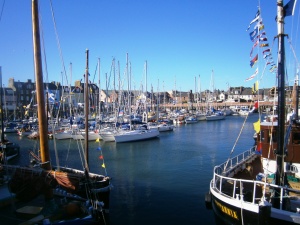
The run down harbour at Arbroath has had new lock gates fitted and pontoons installed to breath new life into the waterfront and harbour, benefitting fishermen and leisure boaters alike. Here all boats, including Sundart, are dressed for the annual “Boatfest”.

The Reaper is the last remaining Scottish sailing herring fishing vessel which is now preserved under the national historical boats register. Apparently it can show a good turn of speed – up to 13 so we heard.

Arbroath is famous for its “Smokies”. We saw several smokeries, all cottage industry establishments. The designation “Arbroath Smokie” has been protected since 2004 under the European Protected Food Name Scheme. This is the Spinks Smokerie – highly recommended from our experience.

Arbroath Smokies – traditionally smoked at Spinks in Arbroath and absolutely delicious

The Charlotte Dundas, which was built in 1801 for carrying goods on the Forth Clyde Canal, was designed by William Symington and was the first practical steam driven ship in the world. The original was broken up in 1861 but this is a more modern 2/3rds replica built in 1986, now languishing at McKay Boat Builders in Arbroath
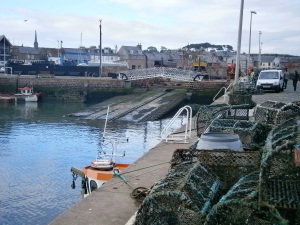
Arbroath has a long tradition of boat building which is still carried out. However, as space is tight the road bridge over the boat builder’s slipway has to open up when boats are winched up the slipway.
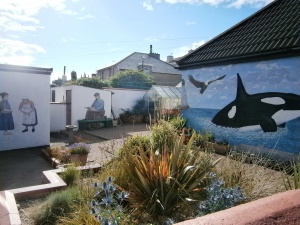
On our walk round Arbroath we came across this surprising series of murals in a back garden in the older part of town near the harbour.

Arbroath has one of the two oldest lifeboat stations in Scotland, with boats being stationed here since 1803. This is their Mersey class boat, which is slipway launched. This station is currently under review. We saw this boat launched three times whilst we were at Arbroath.
We reach Arbroath at 1400, in good time to get into the inner harbour where the marina is located before its lock gates close as the tide falls. The marina is pretty full as Arbroath is holding its annual Boatfest over the weekend. Happily this means there is a special cut price deal for all boats which we benefit from. We raft up against a motor sailer with help from the harbour assistant who also gives us the fob to get out of the marina. It is a council run marina so the arrangements are peculiar as only local councils know how. Not only does the harbour lock work to council hours in the day time only (rather than the norm of operating automatically with the tides over 24 hours) but there is the oddity that you cannot get to the harbour office outside the marina security fence to get the electronic fob that opens the gate in the fence without the fob! Added to that they only have one loo which is in with the shower to serve the hundred or so boats that they can accommodate but they do have a room to hold meetings in and make coffee. This is local council thinking at its best!

Arbroath has a linked series of green spaces that lead from the abbey in town out to the coast and along the coast that are both unexpected to the visitor and a real feature of the town. This grand entrance is at the start of the public park along the coast.
We have a late lunch then take a walk into town. We are surprised that Arbroath was an old abbey town, with some fine ruins dating from the 12th Century. We also find that the town has a linked series of attractive green spaces and parks from the abbey in town out to the coast and a little way along the coast. We wander through these areas before finding ourselves back at the coast in the old part of town.
Arbroath is reknown for its Smokies – haddock that is smoked for a relatively short time over smouldering beech wood. Fish smoking is still a cottage industry located in the old part of town near the harbour. (Apparently the industry started in a nearby village as a result of an accidental fire which burnt some salted haddock in barrels: when the remains were tasted and found to be very edible someone had the bright idea of smoking haddock and hence the Smokie was created. The Arbroath town council later persuaded the smokeries to relocate to the harbour area on very attractive terms to bolster the flagging local economy and hence the Arbroath Smokies came in to being. Nowadays the product has European protection to its designation). We sample some smoked haddock and salmon at the Spinks smokerie, which are both delicious, and purchase some traditional Smokies to consume at supper.
Back at the harbour we wander around, reading the information boards that the local tourist office has provided. Charles spots an old looking boat named Charlotte Dundas over the local boat yard fence. This turns out to be a 2/3rds size replica of the original boat, which was the first practical steam-powered boat in the world. The original, named after his sponsor’s daughter, was designed by William Symington in 1803 for use on the Forth and Clyde Canal, and demonstrated its capability by towing two loaded barges along the canal against a strong headwind, a feat that was impossible by other means available then. Despite this success, the boat did not get much used due to fears of erosion of the canal banks and it was broken up in 1861. However, it paved the way for the development of the steam ship in the UK and USA. This replica was sponsored by Falkirk Council and was intended as a Youth Training Scheme project to complete but when the YTS went the way of such schemes the replica was left stranded by the Falkirk Wheel and is now stored at its makers yard in Arbroath pending some decision on its fate. Hopefully something can be done as the original was truly a world first.
Back on board John cooks supper and we enjoy the Smokies for our starters, helped down with a cool glass of rosé.
Ship’s log
Day’s run: 28.3 nm
Total miles to date: 1630.9 nm
Engine hours: 5.0 hours
Total engine hours: 196.4 hours
Hours sailed: 6.2 Hours
Total hours sailed; 360.4 hours
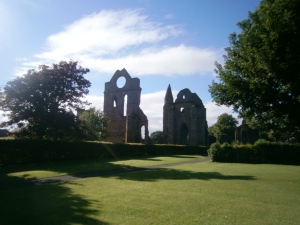
Arbroath abbey dates back to 1178; the ruins are testimony to the power and wealth of this religious foundation. Bell Rock, a dangerous reef about 5 miles off Arbroath is so named as the local abbot had a bell fixed to the rock to warn seamen of the danger. In the 19th century the Stevensons, a famous family of lighthouse builders, overcame immense difficulties and constructed the lighthouse which still serves today.
Friday 2nd August – A day at Montrose and St. Cyrus
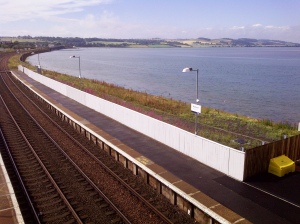
The brackish sea lagoon on the River South Esk seen here behind the railway at Montrose is now a nature reserve and is home to a huge variety of migratory wild fowl. In medeaval times it was a natural refuge for the ships of the time and a major reason why Montrose was only one of four ports in Scotland that was granted a royal charter to import/export goods, thereby laying the foundations to Montrose’s prosperity.

Montrose harbour is host to a wide variety of North Sea oil support vessels, including this one with its helipad on the foredeck. Much of Montrose’s prosperity has always been derived from its harbour.

Montrose used to have a fishing industry – now no more as North Sea oil support and general import/export trade has taken its place. This is a statue near the life boat station in memory of the long gone fishermen by local artist William Lamb

Scotland has a renowned tradition and pride in its education system. This is Montrose Academy.
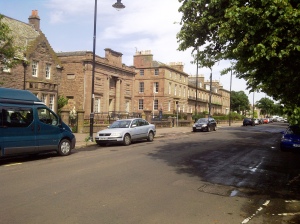
The museum at Montrose overlooking the Links – both being examples of Victorian philanthropy . There are some fine houses in Montrose, testament to its prosperity over many years.

The Links Hotel at Montrose is situated on the Links – a wonderful chain of green spaces and gardens in the middle of Montrose that were the result of Victorian philanthropy. This hotel, which is housed in a former mill owners house, has been providing good quality accommodation for many years – John used to visit Montrose 30 years ago on business and stayed here.

Montrose boasts the widest High Street in Scotland – albeit created by knocking down the row of houses in the middle and extending the gables on the houses at the sides
The next two days are forecast with strong southerly winds, which would make it hard work for us to go south, so we decide to explore this part of the Scottish east coast. We shower before breakfast – not as easy as it sounds given the lack of facilities and the fob system. Around the harbour a variety of stands are being set up ranging from caravan sales through hot dog stands to bric-a-brac stalls and the local lifeboat support stand. A local group starts playing over the loudspeaker system.
A full cooked breakfast sets us up for the day before we walk to the station and catch the train along the coast to Montrose. There is a good service along this line and the ride along the coast is very pleasant with stretches of the line running along the cliffs overlooking the sea.
We have arranged to meet Tammy, Yvonne’s niece who lives at St. Cyrus just north of Montrose but as we have two hours before meeting her we have time to wander round Montrose. John used to work here for Cadbury’s about 25 years ago when they had a food cannery at the harbour and is curious to know what became of it all. We walk to the Links – a lovely stretch of linked green areas through Montrose with some fine buildings that were the result of Victorian philanthropy and planning. We visit the local museum and tourist information office.
Montrose has long been a wealthy town with much of its wealth being derived from the harbour. It was one of only four medieval Scottish ports that were licensed by the Scottish kings to import and export goods on account of its good river and shelter for boats. The harbour continues to bring prosperity to the town to this day, augmented by there being excellent farming inland and various manufacturing g concerns such as Glaxo Smith Kline (the pharmaceutical giant).
John and Charles set off to the harbour to discover that the cannery is now a fertiliser factory and the Montrose harbour is given over to being a major North Sea oil support centre with some big and complicated looking ships in harbour. Judith and Yvonne wander into town for a few bits and pieces before repairing to the Links Hotel in search of coffee where we all meet up.

Tammy and Paul Kefford’s house at St. Cyrus: a lovely family home dating from 1764
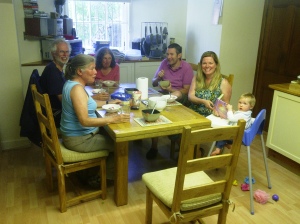
The Kefford family at home – Paul, Tammy and Eve. Son Robbie was away at playschool;
In due course Tammy collects us to take us to her home with the rest of the Kefford family at St. Cyrus.
Tammy and Paul have a lovely old house at St. Cyrus with fine views south over Montrose and a wonderful beach. Their house was built in 1764 and is a fine family home. Elder son Robbie is away at playschool but we meet daughter Eve, who is a happy little soul. Paul is working from home today so it is nice to catch up with him too. Tammy feeds us well on chicken salad before driving us down to the beach.
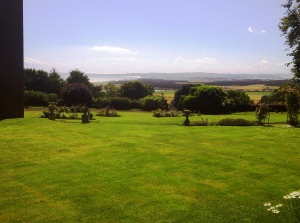
The fine view across to Montrose from the Keffords residence at St. Cyrus

Three generations of White’s – Yvonne, Tammy and Evie – on the beautiful, unspoilt beach at St. Cyrus
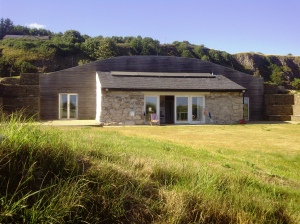
St. Cyrus was once the centre for salmon netting. This is the old ice house complete with turf roof which has been converted into a holiday let

The River North Esk used to run along this valley until a huge storm about a hundred years ago broke through the sand dunes to create a new exit for the river to the sea further south. The bridge was built by the Gurkhas in the 1950’s. Former salmon fishermens cottages behind the bridge. The village of St. Cyrus is up the hill, the beach is behind the camera position.

The beautiful sandy beach, salt marshes, cliffs and sand dunes at St. Cyrus is a wonderful national nature reserve.

Tammy with one year old daughter Eve. The smiles say it all.
The beach at St. Cyrus is a gem, with a huge expanse of unspoilt sand, with bits of driftwood here and there and a feeling of wildness. The rolling dunes behind (that are a nature reserve) boasts a huge array of wild flowers with an old river bed and impressive cliffs just inland. There is the curiosity that the River North Esk used to run along behind the dunes until an enormous storm breached the dunes further south and gave it a shorter way to the sea. The area used to support salmon netting but all that remains of this are the converted fishermen’s’ cottages and the old ice house. We wander along the beach in the sunshine, enjoying the day, before it is time for Tammy to return us to Montrose station and pick up Robbie.
Back at Arbroath even more boats have crammed into the inner harbour, including some heritage boats such as Reaper, the last of the sailing herring fishing boats in Scotland. It is a colourful sight with the boats all dressed in their bunting. After supper, we put up all the flags we have in our locker to decorate Sundart in keeping with the other boats in harbour for Boatfest.
In the evening we see the local lifeboat being launched down the slipway on a “shout” to search for a body in the waters north. Later we see the boat being winched back into its shed – an interesting exercise for those of a technical mind.
All in all a good day.

Hauling the Arbroath lifeboat back up the slipway after a night “shout”.
Saturday 3rd August – a day in Dundee
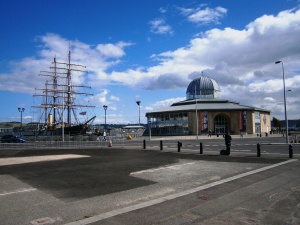
The Discovery Centre at Dundee by the River Tay – an excellent exhibition and a beautifully restored ship
We awake to a lovely day – sunny but with a strong wind from the south. We decide to visit Dundee by train rather than in Sundart. Once again, the train ride is along the coast, past Carnoustie and its famous golf courses and the up-market town of Broughty Ferry just outside Dundee.
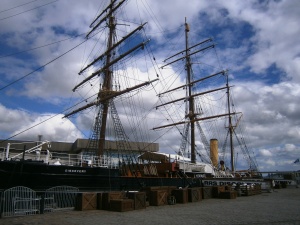
RRS Discovery – returned to the city of its builders after a long service life and now given pride of place on the waterfront in Dundee
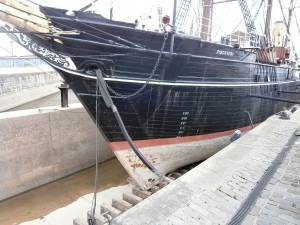
Discovery is built out of 12 types of of wood with three layers forming the hull skin and fitted with a steel sheath to its bows to suit it for service in ice. Wood was chosen in preference to steel as it is better able to flex and withstand the crushing effect of the ice.

The naturalists quarter. It took four assistants to work through and help publish just this body of work after the expedition, such was the quality and quantity of information and samples collected.

Captain Scott’s cabin.
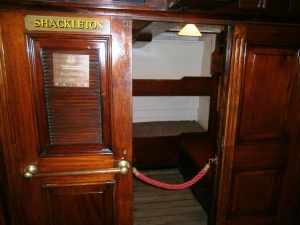
Earnest Shackleton was a junior officer on Discovery and had his first taste of the Antarctic on Scott’s 1902-1904 expedition.

The mens’ quarters on Discovery. The boat was run as a Royal Navy ship, with the same differentiation between men and officers. The mens’ quarters were cramped with little privacy. It appears that Scott ran a good ship.
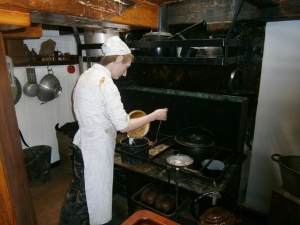
The galley on Discovery. Great efforts were made to ensure the expedition had a varied and healthy diet. They went through three cooks (including one who was clapped in irons for insubordination) before finding the ideal person. Stores had to be carried that were sufficient for two years, supplemented by what they could hunt. Scott forbade any hunting except for food or research.

Makers plate for Discovery. The boat was constructed to the design of the Royal Navy designer of ships. It was constructed in Dundee as they had the greatest experience of building and sailing whaling boats for Arctic and ice bound regions.
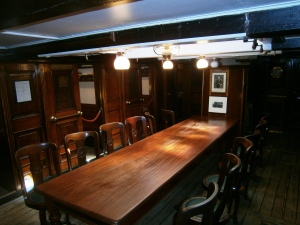
The Wardroom where the officers and senior scientists lived. The cabins open directly off this room. The table and chairs are fixed to the floor, although the chairs swivel

The chart room on Discovery. We use the same size Admiralty charts as seen here – but in a tenth of the space!
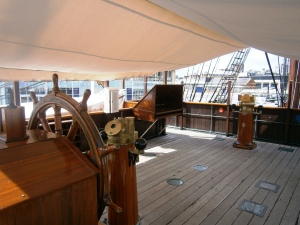
The bridge on Discovery. Two men would normally steer the boat.
Dundee was once a city known for “jute, jam and publishing”, to which could be added whaling and ship building. Nowadays it only has the publishing left out of these industries. The planners have not always been kind to Dundee and we walk past 1960’s buildings awaiting demolition or reduced to heaps of spoil on our way to the Discovery Museum. A branch of the V & A Museum is due to be located here on a rejuvenated waterfront. One hopes the planners make a better job this time round – but we are unconvinced by the billboards depicting the new development.
The Discovery Centre is based round RRS Discovery, the ship specially built in 1901 in Dundee for research in the Antarctic. The ship itself has been fully restored but before going on board we pass through the exhibition. This is excellent and we spend the best part of two hours in it before going aboard.
The Discovery Expedition was originally promoted by the Royal Geographical Society of London for the British National Antarctic Expedition and was assisted by the British Government through the Royal Navy. Antarctica was an unknown place at the end of the 19th century and its exploration was akin to exploring the Moon or Mars today. Various countries had staked claims to bits of the edges of the continent and the British were keen to establish their own chunk as well as to explore the geography and fauna there.
The Royal Research Ship Discovery was the first ship specifically designed for exploration of the polar seas and a great deal of thought went into its design and construction. The design relied on experienced gained by the Dundee and other whaling fleets that frequented Polar Regions. Twelve different types of wood were used for the construction as this was believed to be better able to flex and withstand the pressures of the ice rather than steel which could buckle and fracture.
The ship was crewed by Royal Navy personnel with Captain Robert Falcon Scott chosen to lead the expedition. Earnest Shackleton was a junior officer. Leading scientists of the day were recruited to lead the research into a diverse range of disciplines including geology, the earth’s magnetic fields, biology, zoology and the climate.
It was expected that the expedition would take two years and sufficient provisions had to be carried for this duration, to be augmented by what they could hunt and catch whilst in Antarctica. A lot of thought went into ensuring there was a wide-ranging and balanced diet to ensure the ship’s company stayed healthy and could enjoy their food.
The Expedition was a remarkable success, both in terms of the exploration and the scientific results. The ship was locked in the ice for over two years whilst the work went on. Eventually the Royal navy sent a rescue ship with orders not to stay for a third winter and to abandon the ship but Scott and his crew used controlled explosions to work their way through ten miles of ice to the open sea and returned triumphant to London. They had surveyed huge areas to the continent, opening the way to subsequent expeditions to the South Pole. There was a huge body of high quality scientific work that took years to collate and publish.
Discovery had to be sold as despite the success the expedition was in financial difficulties. The ship became a cargo vessel for the Hudson Bay Company and with the exception of a brief return to Antarctica to rescue the Shackleton Expedition in 1916 continued as a cargo ship until the 1920’s. In 1924 she was fully re-fitted and once again returned as a research ship to Antarctica to chart whale migrations and be part of the British Australian New Zealand Antarctic Research Expedition (BANZARE). She subsequently became a cadet ship and a Sea Scouts Ship. In decaying condition, she was rescued from the breakers yard in 1979 and moored on the Thames Embankment. Finally, she was purchased by Dundee Heritage Trust in 1985 and returned triumphant to the city of her construction for full restoration to her condition in 1924 and dry dock as the centre piece of the Discovery Centre.
We spend two hours in the exhibition before boarding the ship, which has been beautifully restored. There is a good postscript after leaving the ship in the form of a presentation of the work on the current British Antarctic Survey and its scientific work including climate change and understanding how the ecology of this region works and is changing.
This is rightly rated as a five star attraction and is well worth the time to visit it. 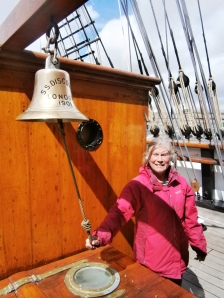
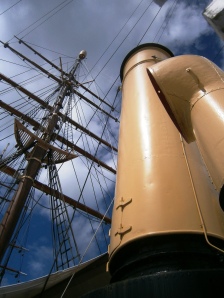
Discovery is primarily a sailing ship with auxiliary steam propulsion. The steam engine consumed 7 tonnes of coal per day when running so with about 300 tonnes of coal capacity and no re-fuelling possible in the Antarctic it was only used when the power was needed. Most of the coal carried was used for heating and cooking.
There is not room in this blog to list all that was done on the Discovery Expedition but further information can be obtained at http://en.wikipedia.org/wiki/Discovery_Expedition and http://en.wikipedia.org/wiki/RRS_Discovery

Probably the best filled sandwich you will ever get – found at Soo Delicious at Dundee with its proprietor
Rather hungry, we walk into the city centre and find what has to be the best lunch deal in town – big bowls of excellent soup and the best filled sandwiches we have seen.

Caird Hall, City Square dating from 1914

Dundee was known for its jam, jute and printing but only the latter survives. It is the home of comics such as the Beano – here celebrated by Desperate Dan, Knasher and Mini the Minx in High Street.
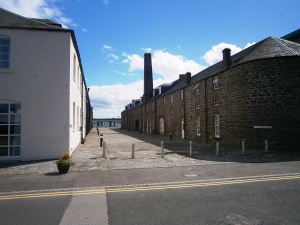
Not all old area of Dundee have been torn down by the city planners. This is the restored Chandlers Row by the old docks.
After a short walk through the city we walk on to the other historical ship in town – the Unicorn.  This is a frigate dating from 1924 and is billed as the oldest floating warship in the world.
This is a frigate dating from 1924 and is billed as the oldest floating warship in the world.
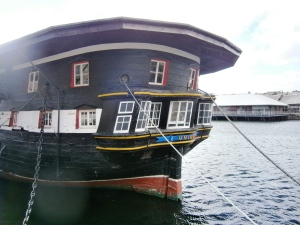
The richly decorated stern of HMS Unicorn.
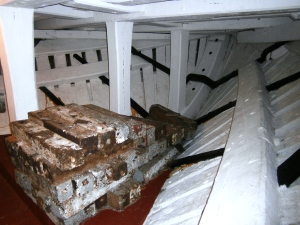
Ships need ballast at their lowest point to keep them upright – especially sailing vessels. This is the standard navy cast iron ballast used 200 years ago. Note also the solid construction of the hull of HMS Unicorn as seen in the bow – all English oak.
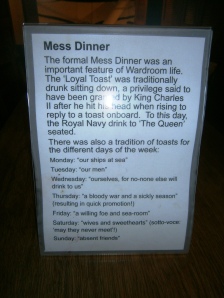
The Royal Navy toasts

The captains quarters on HMS Unicorn. These were typical of the day, although the fine furniture was traditionally towed behind the vessel in a jolly boat and guns were mounted in this area when the ship was cleared for action.
It should be on a par with Discovery as it is the genuine article, having been built at Chatham in the aftermath of the Napoleonic Wars as a fast, 46 gun frigate. It was never sailed, but was laid up “in ordinary” in the naval reserve without masts and rigging and with a roof over the deck (which was the standard laying up procedure of the day) which is still in place. The ship is afloat in the run down docks to the east of the city and is in a mixed state of repair. However, there has been no money spent on the ship or the exhibition. The Trust that runs it is clearly short of funds as the ship is used for weddings and other functions. It is fitted out with fibre glass replica canon, some very shabby seating and is generally in a poor way. We leave rather disappointed as heavy metal rock music sounds out from the next wedding and people turn up with dreadlocks and kilts – all rather bizarre. One hopes that the ship can be rescued properly and made into something that its historical provenance deserves.
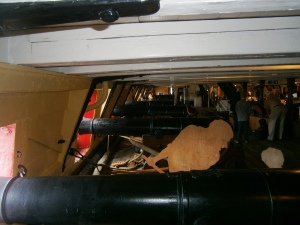
The gun deck – although these canon are fibreglass replicas. Frigates like Unicorn carried 46 guns and were the fastest ships in the fleet. Headroom is very limited!
We return to Arbroath after another good day.
Sunday 4th August – to the Firth of Forth
The weather is looking good to travel south so we leave Arbroath when the harbour lock opens at 10, pausing to fuel up in the outer harbour before setting sail south. There is a stiff breeze and bright sun so we set two reefs and beat down the coast, past the Tay Estuary and along the Fife coast.
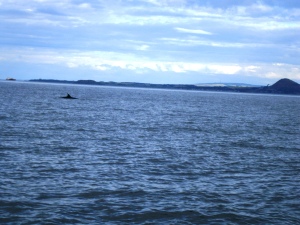
A Minke whale in the Firth of Forth. Although much larger than seals or dolphins, whales keep their distance and are much harder to photograph.
Before long we are tacking past the Isle of May at the mouth of the Firth of Forth and knocking out the reefs as the wind moderates an d turn from south to west – bang on the nose for our journey west up the Forth! Chris Mitchell, who sailed with Charles on Sundart from Mallaig, lives at Kinghorn near Burntisland opposite Edinburgh and has offered us a free berth there. We end up motor sailing into the wind as the Firth of Forth is big – it is nearly 50 miles from Arbroath to Burntisland. We spot a Minke Whale near the boat and try to take a photo but it is rather far off. (Whales tend not to get close to boats, unlike dolphins and seals which seem naturally inquisitive).

Evening arrival at Burntisland on the Firth of Forth. Edinburgh is on the far shore.
We eventually reach Burntisland at 9 PM. Chris is there to see us in and show us the old pontoons in the vast but nearly deserted inner harbour which will be our home for the next couple of days whilst we visit Edinburgh.
Chris has prepared a curry at his home for us, which is excellent. He returns us to the boat around midnight and we wearily turn in.
Ship’s log
Day’s run: 54.9 nm
Total miles to date: 1685.8 nm
Engine hours: 6.8 hours
Total engine hours: 203.2 hours
Hours sailed: 11.0 Hours
Total hours sailed; 371.4 hours
Monday 5th August – Edinburgh

Before the Forth Railway Bridge was constructed in the 1890’s passengers for the north east of Scotland had to take the railway ferry from Granton to Burntisland on the north shore and continue their journey from there. Once the bridge was complete the railway line was diverted round the original Burntisland station, which has been standing forlorn since then complete with redundant buffers. These days it is used as offices – a splendid Victorian building in a run down location.

Sundart moored in the vast harbour at Burntisland with only a few work boats for company. We were happy to have a free mooring so convenient for Edinburgh
Charles and Judith are leaving for home today so the ever helpful Chris returns to ferry them round the large harbour to the railway station on the other side. We get a lift into Burntisland for some basics shopping. Chris finds us a replacement Gaz bottle (as we having difficulty finding this) and kindly donates the cost to our charity.
Shopping done, we take the train into Edinburgh to visit the Festival which we have heard much about. The train crosses the Forth Bridge, which is a bonus (at least for John!).
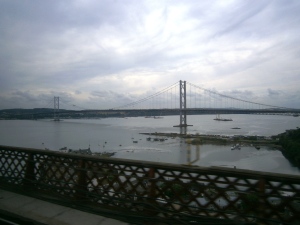
The Forth road bridge as viewed from the Forth Railway bridge. A second road bridge is under construction to provide more capacity. The wires in the suspension cables have been corroding, which had been thought to limit the life of the original road bridge but new techniques involving passing warm dry air over the cables within an insulated sheath may well overcome this problem. meanwhile, the massive railway bridge which is over 100 years old carries on: new paint technology means that the railway bridge does not even have to be continuously repainted.

The Queens Gallery at Holyrood for exhibiting the extraordinary artistic riches that are in the monarch’s collection.
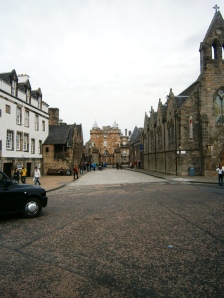
The end of the Royal Mile and part of Holyrood Palace at the end.

The Scottish Parliament Building – the pinnacle of commissar concrete design so favoured in Scotland. Some of the concrete is already showing signs of staining. Inside there is some fine woodwork
The Edinburgh Festival is well-known, with world-class performances of music and theatre plus the ever-expanding Fringe over most of August. We have wanted to visit it for some time and have the added incentive that Alex, son of our friends Jenny and Steve Hollingsworth, is performing in a Fringe production this evening in the centre of Edinburgh.
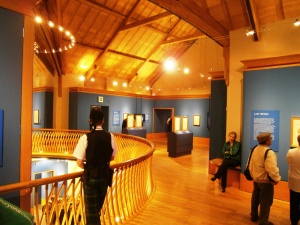
The Queen’s Gallery at Holyrood – modern and attractive.
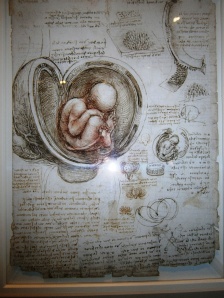
Leonardo’s drawings of a foetus in the womb. He was very curious about how the mother’s and babies blood are separate but the one nourishes the other. As with so many of his anatomical studies, modern science has shown how accurate his observations were: in this case the child is in the breach position. Leonardo always wrote in mirror writing as he was left-handed and found mirror writing easier; it was not done for concealment.
A further attraction is that there is an exhibition of the anatomy drawings and studies by Leonardo da Vinci at the Queen’s Gallery at Holyrood Palace. John has wanted to see these for a long time, having read about the remarkable feat that Leonardo achieved. The exhibition lives up to its reputation. The drawings are truly remarkable. The exhibition compliments the drawings with a good audio commentary and 3D images from modern CT and MRI scans of the human anatomy to show how accurately Leonardo portrayed the human body. Leonardo was, of course, a skilled artist and engineer as well as an anatomist so his insights into how the body functions and moves are special. Sadly, Leonardo was unable to publish his works so they were collected together at his death, bound and effectively lost to sight. They were purchased, along with many other works by Leonardo, by Charles II and remained hidden in the Royal Collection until their worth was finally recognised at the end of the 19th Century, when their publication caused huge interest and admiration then and since. Had they been published at Leonardo’s time they would have been the single most important medical treatise to have been published.

One of Leonardo da Vinci’s studies of the leg and foot showing how the tendons and ligaments work. His very finely detailed drawings and extensive descriptions and notes were all done using a goose-quill pen. Leonardo believed that you had to have accurate drawings AND text to be able to explain the intricacies and interactions of the anatomy. Other drawings showed his studies on the layers of bone, muscle, tendons, blood vessels and the skin that make up the human body and also how they worked and the lines of the forces that are generated as the body works.
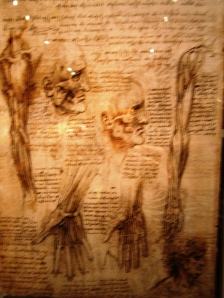
This sheet shows Leonardo’s very detailed anatomy of the hand and arm. He was fascinated with the way complex joints of the body work such as the shoulder and hand and produced numerous “freeze frame” drawings that we only now can produce as moving 3D images using techniques such as CT and MRI scans. These manuscripts are Leonardo’s notes which he intended work up to publish as a book on anatomy.
We leave the Leonardo’s and wander back up the Royal mile. It is a warm and sunny day and the Fringe is in full swing. The top half of the Royal Mile is closed during the Festival. Around St. Giles Cathedral and beyond the street entertainment is in full swing and we enjoy the jugglers, music and performances along with the huge crowds. We buy tickets for Alex’s play at the Fringe Box Office – there must be a very effective computer system behind the Festival given the huge number of events that are on and the different outlets for the tickets.


The Fringe ticket office – a slick operation with other outlets all plugged into the same system and mainly staffed by young people.
We enjoy an evening meal in the sun sitting outside at a café watching the world go by before moving on to the venue for the play. By good chance Alex turns up with the rest of the actors so we can pass some time with him before the play starts at around 9. Called Vessel, the play concerns the circumstances surrounding building a boat by five siblings in memory of the death of their brother. It is billed as a comedy but it is certainly more than that. The play is very well done by the cast of 5.
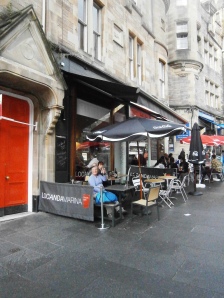
The cafe society gets into full swing during the Edinburgh Festival
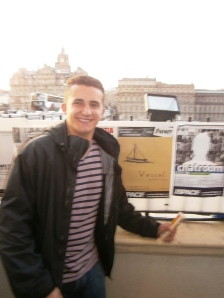
Alex Hollingsworth poses in front of the poster for the play Vessel that he is acting in Edinburgh Fringe. Go and see it!
We return to Sundart and turn in before midnight after another different and entertaining day.
Tuesday 6th August – To Dunbar
John sets the alarm wrong so we get up at 0645 but no harm as we have plenty of time to breakfast and meet Chris around 0830. Chris will sail his boat with us for some of the way out of the Firth of Forth on our way to Dunbar (which is at the southern entrance to the Firth around 26 miles from Burntisland).

Chris Mitchell was tremendously helpful with arranging the mooring for Sundart at Burntisland, feeding us after a late finish and generally looking after us. He accompanied us at the start of our sail east out of the Firth of Forth in his boat Mistral
It is a lovely morning, with a light westerly wind. We leave our berth at 0900 and sail with Chris towards Edinburgh. As the wind is light and we need to be at Dunbar by 3PM to get into the harbour, we set the spinnaker and gradually leave Chris behind as we pass Incholm and sail east. It is a lovely sail as we cruise along the Firth.
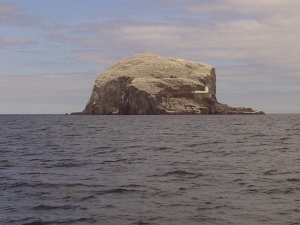
Bass Rock in the Firth of Forth opposite North Berwick. This rock (which is an ancient volcano “plug”) is famous for its colony of gannets and even provides the scientific name for the gannet: sula bassana. The rock looks white from any direction from the gannet guano.
We pass Edinburgh, and later pass North Berwick then Bass Rock, which is famous for its gannets. The rock is extremely white and although the nesting season is over there are gaggles of gannets to be seen. We pass round a fleet of RS400 dinghies racing – North Berwick is a popular place for dinghy racing and national championships.
We reach Dunbar on time with a little help from the engine as the wind dies. The entrance to the harbour is spectacular – it was blasted through the rock and old castle walls about a century ago. There is a leading line and bearing that we have to follow into the narrow cleft between the rocks before the harbour opens out. The assistant harbour master meets us and takes our lines at the visitor’s berth, which is immediately below the old castle walls. Kittiwakes are nesting in the walls, being kept very busy feeding their young which are nearly ready to fledge. There is a considerable noise but it is a wonderful display. We will wait at Dunbar until tomorrow afternoon when Pam Deacon will join us so we will look forward to exploring this attractive little town.
Ship’s log
Day’s run: 26.5 nm
Total miles to date: 1712.3 nm
Engine hours: 2.2 hours
Total engine hours: 205.4 hours
Hours sailed: 5.0 Hours
Total hours sailed; 376.4 hours
A following wind and fair weather to you all.
Yvonne and John
 This is probably our last post on this blog and is a simple, big thank you to everyone who has contributed to our charity. We have now raised over £5000 towards SUDEP Action, which is a fantastic figure to have reached and far exceeds our wildest hopes.
This is probably our last post on this blog and is a simple, big thank you to everyone who has contributed to our charity. We have now raised over £5000 towards SUDEP Action, which is a fantastic figure to have reached and far exceeds our wildest hopes.




